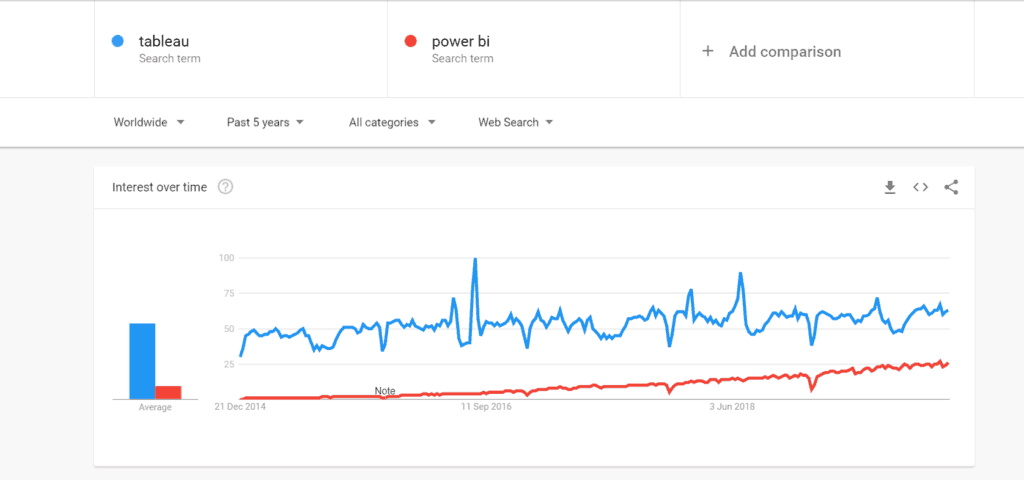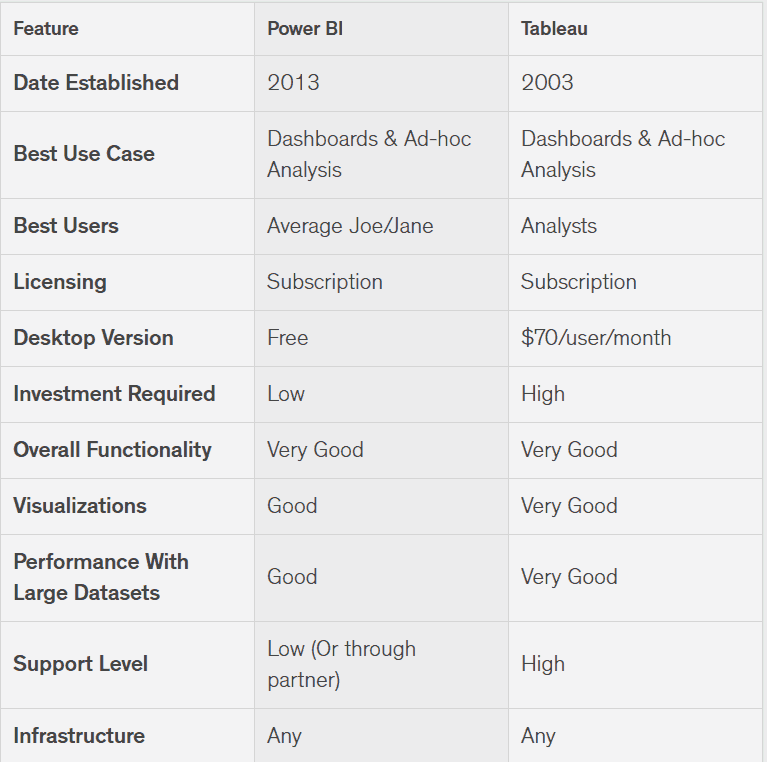Here in this blog of Tableau vs Power BI Codeavail experts will discuss business intelligence and data visualization tools, in particular, two names that power BI and Tableau can think of. These two tools are helpful when you refer to data visualization. Wonder which will be helpful according to needs?
Tableau or Power BI are very similar products, and you have to look quite closely to figure out which product might work best for you. Codeavail experts specialize in both Tableau and Power BI.

Tableau vs Power BI
Table of Contents
- Tableau is developed for data analysts, while Power BI is a better fit for a general audience that needs business intelligence to improve their analytics.
- Power BI begins at a lower price point than Tableau, but system features and additional users will increase that price.

Both Tableau and Power BI are not single market leaders in the business intelligence space. To explore your research method and get a shortlist of Microsoft BI software that performs for your data requirements.
Power BI
Power BI works on the existing Microsoft systems like Azure, SQL, and Excel to make data visualizations that do not break the bank. Almost, that is a great choice for those who already operate within Microsoft products like Azure, Office 365, and Excel. It’s also a fairly good low-price option for SMBs and startups who need data visualization but do not have a lot of extra resources.
Tableau
Tableau specializes in building beautiful visualizations, but many of their promotion is focused on corporate environments with data engineers. Almost, there is a public (free) version of the tool, but with limited capabilities. As well as, the more you pay for the tool the more you can access Tableau, including benchmark data from third parties. Also, it has a non-profit tool and versions for academic settings.
Power BI vs Tableau Setup
Moreover, Power BI comes in three forms: mobile form, desktop form, and service form. Depending on your role and needs you might use one or all of these services to build and publish visualizations. The most basic set up is an Azure tenant that you connect to your Power BI through an Office365 Admin interface.
Although that seems horrifying, most companies who use the software will already have the framework in place to get up and running instantly. Power BI is fairly easy to use, and you can immediately connect existing data sources, spreadsheets, and applications via built-in connections and APIs.
Tableau allows you to set up your first example through the free trial, which gives you full access to the parts of the tool. In fact, from the where opening dashboard, you can see a list of all of your available connections.
For example: Start connecting your data sources, and then you can start creating a worksheet where your visualizations will live. Finally, If you built your visualizations in Tableau Desktop, you can share them with your team via Tableau Server or Tableau Online.
Dashboards
Power BI has its API access and pre-built dashboards, some of the most commonly used technologies such as Salesforce, Google Analytics, email marketing and of course for quick insights for Microsoft products. You can join services within your organization or download files to create your visualizations.
To connect any data to Power BI, you need “Get data” The button has to be used. You have to go through a small authorization process to fully connect.
Tableau invested heavily in the integration and connection of large tools and widely used connections. You can view all connections included with your account level when you enter the tool.
The tableau connection is a bit more involved because you need to identify which data you need to pull in the tool when creating a connection. Because of this, it can help to understand which data you want to see and why you start creating those connections before.
Tableau vs Power BI Feature

Cost
Talking about large enterprises, the tableau will be more expensive than the power BI. Also to get the most out of the tableau you have to build data warehousing that will further increase the cost.
Power BI is the clear winner here if you are looking for an affordable solution. The Cost of Power BI Professional Edition is less than $10 per user per month while the Pro version of Tableau exceeds $35 per user per month.
If you’re a startup or a small business, you can opt for Power BI and then upgrade the tableau if needed.
Data Visualization
If your primary objective is data visualization, Tableau is the most selected option. Tableau is the best tool when it comes to data visualization, while Power BI focuses more on predictive modeling and reporting.
Deployment
Tableau has more flexible deployment options than Power BI. Power BI is only available as a SaaS model while tableau has got both on-premises and cloud options.
If your business policy does not allow for SaaS for some obvious reasons, Power BI is out of the picture. Although expensive due to its flexible deployment and licensing options, here’s the tableau winner.
Bulk data handling capabilities
When it comes to handling vast amounts of data sets, Tableau is still better than power BI. When handling bulk data in Power BI, drag slow occurs which can be corrected using a direct connection instead of import functionality.
Functionality
Most of the topics users can answer about available data in Tableau compared to Power BI. The depth of data search with tableau is more advanced than Power BI.
Integration
Both software connects easily with programming languages. Tableau integrates much better with r language than power BI. Power BI can still be linked to the R language using Microsoft Revolution Analytics but is only available to enterprise-level users.
User Interface
Tableau has a clever user interface that enables the user to easily create a customized dashboard. Further, Power BI has a more intuitive interface and is much simpler to learn than tableau. As a result, this is due to the simplicity and ease of use of why business users like Power BI.
Why customers choose Tableau over Power BI
You can create dashboards with Power BI or Tableau, but the biggest difference is the way you experience insights through analysis. With Tableau, the ultimate goal of your analysis is not the dashboard – it’s a better understanding of your data. And in tableau, you can dig deep into an exterior or iteration on your search without breaking the flow of analysis.
Tableau is a fully integrated and extensible platform that uses your existing data strategy, providing the most flexibility and options in deployment and data source connections – without hidden fees or limitations. That’s why analysts report that there’s a 29% lower cost of ownership in tableau than Power BI.
Which is better career growth – Tableau or Power BI
Certainly in the enterprise world, Power BI will be king because a lot of organizations receive it as an add-on in their MS software service pack.
Tableau will be the winner in more specific areas as it has roots in Academies. It has crossed this upbringing and it is everywhere.
If you choose one of these, you will have a safe career. The reason is easy to learn and use both. Both are very popular in the market and have strong markets.
What can Tableau do that Power BI cannot, and vice versa
For your understanding in a convenient way, below are some points that will help you to easily remember the difference. These are:
1. Advantages of Power BI on Tableau
- Power BI gives automatic quick insights.
- Power BI is a data model that supports a large number of tables and also has complex relationships between tables, while Tableau does not support more than a trivial data model.
- Its data engine is 10 to 100 times faster than the Tableau data engine.
- Power BI can integrate with Cortana, Excel, and real-time data feeds.
- Power BI contains dashboards that are important visualizations from reports “High-level view” – the term given by Netz.
2. Advantages of Tableau on Power BI:
- Power BI is restricted with data visualization scans at only 3500 data points, resulting in difficulty working with large data sets, which can be tableau.
- Power BI can’t group data on the fly, as you’ll have to do a lot of prep work for this. But it is not with the tableau.
- In Power BI you can’t find data and slices by more than two categories.
- Power BI has limited ability to customize and format popup content, wrong interpreting data.
- Downloading other people’s dashboards in Power BI is also prohibited, thus limiting your use for additional analysis.
Conclusion(Tableau vs Power BI):
Overall, we call this Tableau vs Power BI to duel a draw. Power BI wins for ease of use, but the tableau wins in speed and capabilities.
If you need any assignment or project help related to Tableau. You can hire Codeavail experts to get the Tableau assignment help service at an affordable price within a given deadline.
